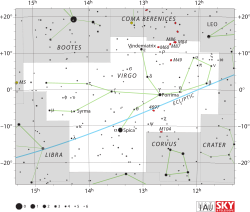
| |
| Observation data Epoch J2000.0 Equinox J2000.0 | |
|---|---|
| Constellation | Virgo |
| Right ascension | 14 43 03.62282 |
| Declination | −05° 39′ 29.5327″ |
| Apparent magnitude (V) | 3.88 |
| Characteristics | |
| Spectral type | F2 V |
| U−B color index | −0.04 |
| B−V color index | +0.39 |
| Astrometry | |
| Radial velocity (Rv) | 5.10±0.7 km/s |
| Proper motion (μ) | RA: +103.28 mas/yr Dec.: −318.63 mas/yr |
| Parallax (π) | 54.73 ± 0.20 mas |
| Distance | 59.6 ± 0.2 ly (18.27 ± 0.07 pc) |
| Absolute magnitude (MV) | 2.57 |
| Details | |
| Radius | 1.99 R☉ |
| Luminosity | 7.474 L☉ |
| Surface gravity (log g) | 4.21 cgs |
| Temperature | 6,751 K |
| Metallicity | −0.05 dex |
| Rotational velocity (v sin i) | 47.0 km/s |
| Age | 1.5 Gyr |
| Other designations | |
| Rijl al Awwa, μ Vir, 107 Vir, BD−05°3936, FK5 545, GJ 9491, HD 129502, HIP 71957, HR 5487, SAO 140090 | |
| Database references | |
| SIMBAD | data |
Mu Virginis, Latinized from μ Virginis, is a star in the zodiac constellation of Virgo. It was listed in the Calendarium of Al Achsasi al Mouakket as rijl al-‘awwā’, Arabic رجل العواء, meaning "The foot of the barking (dog)". With an apparent visual magnitude of 3.88, it is bright enough to be seen with the naked eye. The position of the star near the celestial equator means it is visible from most of the Earth. Based upon parallax measurements, Mu Virginis is located some 59.6 light-years from the Sun.
Rijl al Awwa is an F-type main-sequence star with a stellar classification of F2 V, although it does show some evidence of being a more evolved star. It has an effective temperature of 6,751 K in its outer atmosphere. The estimated age of the star is 1.5 billion years, and it has a relatively high 47.0 km/s projected rotational velocity. A 1990 study of the star gave it a giant star classification, and modeled it with 1.7 times the mass of the Sun, 2.1 times the Sun's radius, and shining with 9.8 times the Sun's luminosity.
Past observations of this star show some indications of short-term chromospheric variability as well as radial velocity variations. It has a candidate common proper motion companion at a projected separation of 770 AU. This object has a J band magnitude of 10.72.
References
- ^ van Leeuwen, F. (2007), "Validation of the new Hipparcos reduction", Astronomy and Astrophysics, 474 (2): 653–664, arXiv:0708.1752, Bibcode:2007A&A...474..653V, doi:10.1051/0004-6361:20078357, S2CID 18759600.
- ^ Mermilliod, J.-C. (1986), "Compilation of Eggen's UBV data, transformed to UBV (unpublished)", Catalogue of Eggen's UBV Data, SIMBAD, Bibcode:1986EgUBV........0M.
- ^ Holmberg, J.; et al. (July 2009), "The Geneva-Copenhagen survey of the solar neighbourhood. III. Improved distances, ages, and kinematics", Astronomy and Astrophysics, 501 (3): 941–947, arXiv:0811.3982, Bibcode:2009A&A...501..941H, doi:10.1051/0004-6361/200811191, S2CID 118577511.
- ^ Gray, R. O.; et al. (July 2006), "Contributions to the Nearby Stars (NStars) Project: spectroscopy of stars earlier than M0 within 40 pc-The Southern Sample", The Astronomical Journal, 132 (1): 161–170, arXiv:astro-ph/0603770, Bibcode:2006AJ....132..161G, doi:10.1086/504637, S2CID 119476992.
- Gontcharov, G. A. (November 2006), "Pulkovo Compilation of Radial Velocities for 35,495 Hipparcos stars in a common system", Astronomy Letters, 32 (11): 759–771, arXiv:1606.08053, Bibcode:2006AstL...32..759G, doi:10.1134/S1063773706110065, S2CID 119231169.
- ^ Rachford, Brian L.; Foight, Dillon R. (June 2009), "Chromospheric Variability in Early F-Type Stars", The Astrophysical Journal, 698 (1): 786–802, arXiv:0904.1620, Bibcode:2009ApJ...698..786R, doi:10.1088/0004-637X/698/1/786, S2CID 693296.
- Moro-Martín, A.; et al. (2015), "Does the Presence of Planets Affect the Frequency and Properties of Extrasolar Kuiper Belts? Results from the Herschel Debris and Dunes Surveys", The Astrophysical Journal, 801 (2): 143, arXiv:1501.03813, Bibcode:2015ApJ...801..143M, doi:10.1088/0004-637X/801/2/143, S2CID 55170390.
- ^ Schröder, C.; Reiners, Ansgar; Schmitt, Jürgen H. M. M. (January 2009), "Ca II HK emission in rapidly rotating stars. Evidence for an onset of the solar-type dynamo" (PDF), Astronomy and Astrophysics, 493 (3): 1099–1107, Bibcode:2009A&A...493.1099S, doi:10.1051/0004-6361:200810377
- "* mu. Vir". SIMBAD. Centre de données astronomiques de Strasbourg. Retrieved 2016-09-08.
{{cite web}}: CS1 maint: postscript (link) - Allen, R. H. (1963), Star Names: Their Lore and Meaning (Reprint ed.), New York, NY: Dover Publications Inc., pp. 473, ISBN 0-486-21079-0
- Malagnini, M. L.; Morossi, C. (November 1990), "Accurate absolute luminosities, effective temperatures, radii, masses and surface gravities for a selected sample of field stars", Astronomy and Astrophysics Supplement Series, 85 (3): 1015–1019, Bibcode:1990A&AS...85.1015M.
- Chini, R.; et al. (January 2014), "New visual companions of solar-type stars within 25 pc", Monthly Notices of the Royal Astronomical Society, 437 (1): 879–886, arXiv:1310.2684, Bibcode:2014MNRAS.437..879C, doi:10.1093/mnras/stt1953, S2CID 118717758.